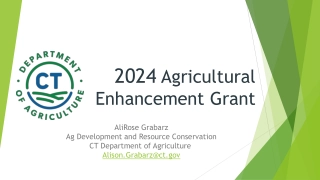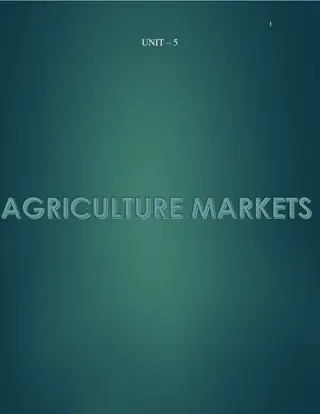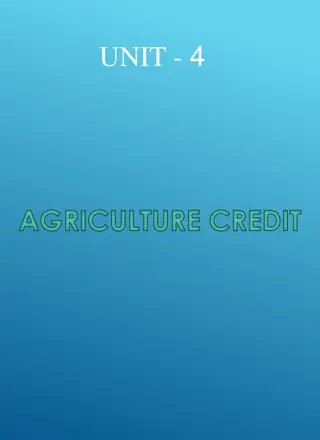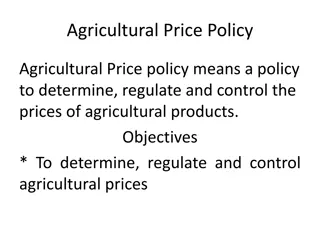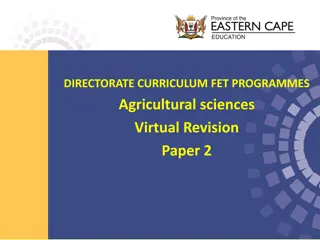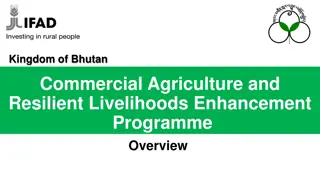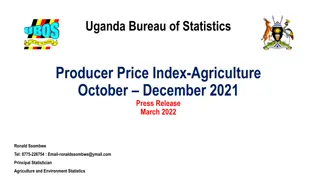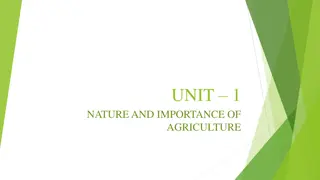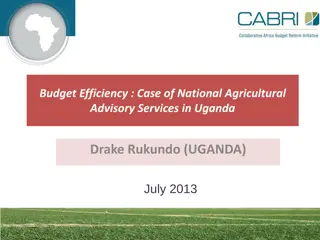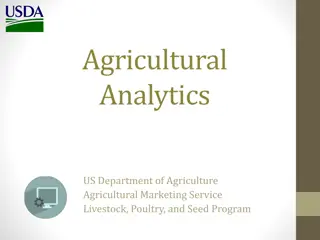Lucerne Production and Marketing for Agricultural Advisory Services
Lucerne, a perennial crop grown widely as forage for cattle, requires well-drained soil and specific climatic conditions for optimal production. It is drought-tolerant but responsive to irrigation. Choosing the right seed variety based on winter dormancy is crucial for successful lucerne cultivation in South Africa.
Download Presentation

Please find below an Image/Link to download the presentation.
The content on the website is provided AS IS for your information and personal use only. It may not be sold, licensed, or shared on other websites without obtaining consent from the author.If you encounter any issues during the download, it is possible that the publisher has removed the file from their server.
You are allowed to download the files provided on this website for personal or commercial use, subject to the condition that they are used lawfully. All files are the property of their respective owners.
The content on the website is provided AS IS for your information and personal use only. It may not be sold, licensed, or shared on other websites without obtaining consent from the author.
E N D
Presentation Transcript
PRODUCTION AND MARKETING OF LUCERNE NTOKOZO MDLALOSE SPECIALIST AGRICULTURAL ADVISORY SERVICES: NORTH REGION NOVEMBER 2012
OUTLINE Lucerne Production Lucerne Marketing Economics
LUCERNE PRODUCTION Lucerne is a perennial crop with a productive stand life of 5-7 years. It is widely grown as forage for cattle and is often harvested as hay.
Paddock selection Lucerne requires a well-drained soil for maximum production. Lucerne will not tolerate waterlogged soils. All weeds including grasses should be eliminated when preparing the seedbed.
CLIMATIC CONDITIONS Lucerne is drought tolerant and has a deep rooting system. It grows well in climatic ranges of between 10 C and 30 C. The optimal growth temperature is estimated at 20 C.
IRRIGATION Lucerne is renowned for its drought tolerance, but at the same time is very responsive to water. It responds well to irrigation. Avoid sowing lucerne into dry soil Seedling plants should have adequate moisture for successful establishment.
SEED VARIETY Each variety is associated with a winter dormancy number. Winter dormancy is numbered from 1 to 10. Where, 1- The plant is strongly dormant during winter 10- The plant is winter active or non-dormant.
SEED VARIETY In South Africa the following classes are the most suitable for our climatic regions: 5 - Semi-dormant 6 & 7 - Intermediate dormancy 8 - Winter active/non-dormant 9 - Highly winter active/non-dormant
SEED VARIETY The more winter dormant a variety, the longer its lifespan and the better adapted it is to grazing. The less winter dormant a variety, the shorter its lifespan and the more suited it is for hay production.
SEED VARIETY Variety PAN 4546 Pub 5681 PAN 4764 Phb 58N57 Dormancy Group 5 6 7 8
SEED PRICES Prices as follows (excl. VAT): Lucerne - SA Standard = R50.40 /kg - dormancy 5 1. Lucerne - Gea = R68.25 /kg - dormancy 7 2. Lucerne - Marina = R68.25 /kg - dormancy 7/8 3. *Prices obtained from Bulk Seed Company
TIME OF PLANTING Lucerne may be planted in either autumn or spring. Spring sowing can begin in September-November. Autumn planting can begin in February-April.
SOWING RATE The seeding rate for lucerne vary from 12-18 kg/ha with differences based upon region, soil type, and seeding method. The recommended seeding rate is 15kg/ha.
SOIL pH AND LIMING Lucerne is one of the few crops which will thrive on a soil with a high pH. Acidity will not be tolerated. For maximum yields, the land should be limed to a pH of 6.5 to 6.8. Yield of lucerne drops rapidly in soil of pH less than 6.7
YIELD Yields vary with region, weather, and the crop's stage of maturity when cut. Yields also depend on the plant population, maintenance of the crop and the variety that has been cultivated. Average yield ranges between 15 000 kg to 30 000 kg per hectare. The first cutting gives an average yield of about 1.5-2 tons/ha. and then the yield increases during subsequent cuttings.
HARVESTING TIME Lucerne is mechanically harvested First cutting should commence at the bud stage and the subsequent cuttings follow just after flowering. It is expected that the period between Planting to first cut is 42 days. You can cut lucerne five or six times a year.
CROP ROTATION Lucerne exhibits autotoxicity. In other words lucerne plants produce a chemical(s) which suppress the germination and growth of lucerne seedlings. Therefore, it is recommended that alfalfa fields be rotated with other species (for example, corn) before reseeding. A rotation of 5 years is advised between lucerne crops.
LUCERNE CAN BE USED FOR: GRAZING The pasture is not harvested but grazed by livestock. Lucerne has excellent qualities for grazing, but it can cause bloat. SILAGE Fermented high moisture fodder that can be fed to ruminants.
LUCERNE CAN BE USED FOR: HAY Cut, dry and store lucerne for use as livestock fodder during times of scarcity. FEEDING Dairy farmers and beef cattle farmers use it to feed their animals on a daily basis to sustain good levels of animal performance.
LUCERNE CAN BE USED FOR: HUMAN USES Lucerne is not only a valuable animal feed, but also has alternative uses, e.g. as a health food for humans. can be used against allergies, arthritis, pregnancy sickness, stomach ulcers, and bad breath. Lucerne is usually used either as pills, capsules or as a tea.
LUCERNE MARKETS FEEDLOT Livestock is fed until they obtain market weight for good market prices and sold. Feedlots can obtain hay and silage from the farmer to fatten the livestock before slaughtering.
LUCERNE MARKETS DAIRY FARMS Dairy cattle are fed for production of milk. The dairies will purchase hay, silage and other products. GRAZING Livestock from other farms can graze at a rental price.
ESTABLISHMENT COST Equipment Requirements per 1 000 ha ITEM PRICE/UNIT QUANTITY TOTAL PRICE Seeders R 614 665.00 X 1 R 614 665.00 Fertilizer Spreaders R 94 396.50 X 2 R 188 793.00 Sprayers R 75 500.00 X 2 R 151 000.00 Mowers R 148 050.00 X 2 R 296 100.00 Rakes R 125 000.00 X 2 R 250 000.00 Balers R1 034 550.00 X 2 R2 069 100.00 Loaders: Quickie loader R 35 242.75 X 4 R 140 971.00 Bale fork & Attachments R 4 497.50 X 4 R 17 990.00 Big Bag Lifter R 1 395.00 X 2 R 2 790.00 TOTAL R3 731 409.00
ESTABLISHMENT COSTS OTHER ESTABLISHMENT COSTS MAY INCLUDE: HAY TRAILERS TRACTOR IRRIGATION INSTALATION SHED/STORAGE HOUSE OPERATING COSTS
PRODUCT INCOME Afriqua developments has proposed a price of R1 000/ton for Lucerne Hay grade 1. The current market price for Lucerne Hay grade 1 is R1 800/ton.
PRODUCT INCOME At R1 000.00 per ton ITEM UNIT PRICE/UNIT (R) QUANTITY VALUE/HA (R) Lucerne Hay Sold Tons 1 000.00 15 15 000.00 At R1 800.00 per ton ITEM UNIT PRICE/UNIT (R) QUANTITY VALUE/HA (R) Lucerne Hay Sold Tons 1 800.00 15 27 000.00 * NB: Assuming that all hay produce is Grade A
LUCERNE PRICES TWK Price R98.00/bale Assegay Feeds (Durban) R120.00/bale Equerry (Hillcrest) R95/bale and is R65/bale for the same company based in Cape Town. Northern Cape farmer R80/bale Lucerne Hay prices vary from one trader to another.
ESTABLISHMENT YEAR COSTS PRE-HARVEST COSTS ITEM ITEM UNIT UNIT PRICE/UNIT PRICE/UNIT QUANTITY QUANTITY COST/HA COST/HA Lucerne Seeds Lucerne Seeds Kg Kg 88.00 88.00 15.00 15.00 1 320.00 1 320.00 Fertilizer: KCL Fertilizer: KCL Ton Ton Ton Ton 5 275.00 4 275.00 5 275.00 4 275.00 0.20 0.57 0.20 0.57 1 055.00 2 436.75 2 436.75 1 055.00 Supers 10.5% Supers 10.5% Lime: Dolomitic Lime Lime: Dolomitic Lime Ton Ton 1 175.00 1 175.00 3.00 3.00 3 525.00 3 525.00 Agricultural Gypsum Agricultural Gypsum Ton Ton 1 175.00 1 175.00 0.50 0.50 587.50 587.50 Pest Control: Karate Pest Control: Karate Kg Kg 123.28 123.28 0.82 0.82 101.09 101.09 Trace Elements: Sodium Trace Elements: Sodium Molibdate Molibdate Kg Kg 261.19 261.19 0.45 0.45 117.54 117.54 Irrigation Irrigation mm mm 3.44 3.44 800.00 800.00 2 752.00 2 752.00 TOTAL TOTAL 11 895.69 11 895.69
ESTABLISHMENT YEAR COSTS HARVEST COST ITEM UNIT PRICE/UNIT QUANTITY COST/HA Packaging: Twine Kg 38.74 30.00 1 162.20 Transport Ton 150.00 15.00 2 250.00 TOTAL 3 412.20 INDIRECTLY ALLOCATABLE COSTS ITEM UNIT PRICE/UNIT QUANTITY COST/HA Fuel Litres 11.80 170 2 006.00 Repairs & Maintenance 1 490.00 TOTAL 3 496.00 TOTAL ESTABLISHMENT YEAR COST 11 895.69 + 3 412.20 + 3 496.00 = R18 803.89
PRODUCTION YEARS 2-5 PRE-HARVEST COSTS ITEM UNIT PRICE/UNIT QUANTITY COST/HA Fertilizer: KCL Ton 5 275.00 0.47 2 479.25 Supers 10.5% Ton 4 275.00 0.57 2 436.75 Trace Elements: Sodium Molibdate Kg 261.19 0.45 117.54 Solubor Kg 27.32 5.00 136.60 Irrigation mm 3.44 800.00 2 752.00 TOTAL 7 922.14
PRODUCTION YEARS 2-5 HARVEST COST ITEM UNIT PRICE/UNIT QUANTITY COST/HA Packaging: Twine Kg 38.74 36.00 1 394.64 Transport Ton 150.00 18.00 2 700.00 TOTAL 4 094.64 INDIRECTLY ALLOCATABLE COSTS ITEM UNIT PRICE/UNIT QUANTITY COST/HA Fuel Litres 11.80 166 1 958.80 Repairs & Maintenance 1 452.17 TOTAL 3 410.97 TOTAL COST-PRODUCTION YEARS 2-5 R7 922.14 + R4 094.64 + R3 410.97 = R15 427.75
GROSS MARGIN PER HA ESTABLISHMENT YEAR ITEMS At a price of R1 000 At a prices of R1 800 Product Income 15 000.00 27 000.00 Total Allocatable Costs 18 803.89 18 803.89 GROSS MARGIN -3 803.89 8 196.11 PRODUCTION YEARS 2-5 ITEMS At a price of R1 000 At a prices of R1 800 Product Income 15 000.00 27 000.00 Total Allocatable Costs 15 427.75 15 427.75 GROSS MARGIN -427.75 11 572.25 *Assuming a yield of 15 ton for both, establishment year and subsequent years.



